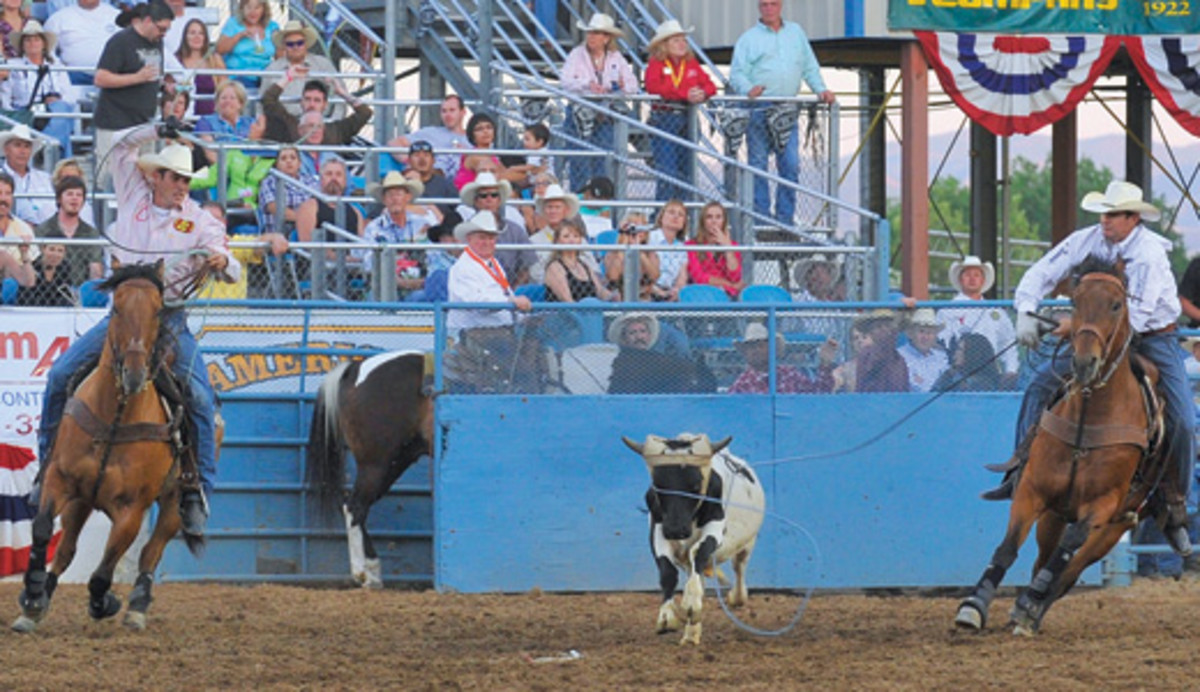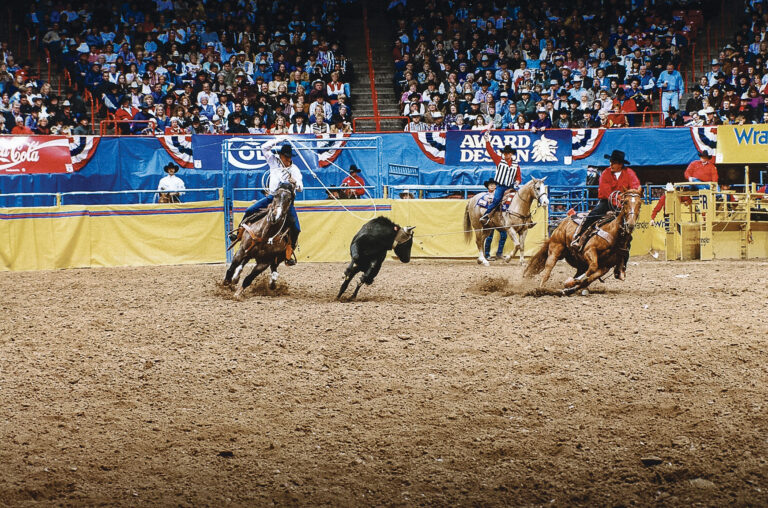
That steer was moving pretty fast across there. It’s a normal shot-my top strand is a little lower than I would want it-my horse is stopping and the steer was strong. There’s nothing unusual about this shot.
When I threw, I’m looking at my loop and the steer jumping into my loop. I was waiting for that to happen before I pull my slack. You want to leave the loop on the ground as long as you can. My hand is ready to pull my slack as soon as I see it. By the next frame, I would be started up with my slack to dally. My horse is working good, my loop looks good and everything is coming together just right.
This is the next picture in the sequence. We had a steer that ducked his head, lowered it pretty good. So it’s really important for my horse to stay free and stay with me for that extra stride so I can keep it on his horns. He’s so free and I rode him good enough that I had to actually cue him to leave.
I’m in the transition of getting ready to dally and pull him off. I’ve got to cue him because I’ve got him too free, but my body position is square with the horse, not hanging off one side.
This is the next one and I’m starting to get that steer’s head. My positioning is still great. I’m just about to square him up and soften the corner and get him ready to heel fast. After all this-and I think we were 5.0 on that steer-he still has not dropped his shoulder and not left or left hard. He’s still framed up the whole way and has kept his positioning excellent.
When your horse does that it softens the corner. When the steer hits out there and they’re ready to heel, his feet will come together good and the heeler can really read it.
My whole body and legs are not hanging off one side or the other. I’m just keeping right in the middle of him and that helps cue him to leave and do the right thing.
This run is a similar outside set up to Reno. This is at Sisters, Oregon. This is our second steer. We had placed in the first round and we had a good steer. I was pretty aggressive. At these two-headers you have to be pretty aggressive now. My horse stayed framed up. I didn’t reach really, I just roped as I was coming to him. I’m still having to cue him to leave, because he’s staying with my and keeping his shoulder up and keeping framed up while I’m dallying. In the next sequence, I will be able to get his head and turn the steer and make him easy for Michael [Jones] to heel.
You’ll notice this steer has his head up, where that other one had his head down. There’s really no difference in how you handle them. When you dally, you don’t want to leave on a loose rope. It should be tight before your horse leaves, that way you always have control of them.
It looks like I’m in the middle of kicking him. If can’t remember if I either dallied over the top of my horn or if I roped out a little bit. We were aggressive on that one. We won the second round, we were like 4.8, and we won the average and had already won second in the first round. We were trying to max out the rodeo.
This one right here I’m just starting the steer’s head. I’m holding my horse up because I want to make sure I soften the corner and make him fast for Michael to heel. This is Colorado Springs, so this is July, not June like we were talking about. Now I have to hold him up and not cue him as much because we’ve been rodeoing for a full month. Everything in this picture is exactly what I want to do. The rope is tight when I’m leaving, I just have to hold him up a little more. He’s obviously not as free after you’ve rodeoed on him for a month and you have to be 4 seconds to place anymore. I’m just trying to keep him where he doesn’t drop his shoulder and makes those handles bad where those steers switch hard and their legs don’t come together.
My left arm is in a good position, cueing my horse to stay with me just a little longer until that steer gets squared up. My upper and lower body is right in the middle of the horse.
You have to adjust to the kind of setup you’re in and the time of year because he’ll allow you to win. Sometimes you have to cue him to leave and sometimes you have to hold him up. It just takes one day of practicing where I free him up and just go rope on him. I might go jackpot on him-maybe one jackpot and a few practice steers. He wants to be free, so as long as I can take my time and practice, he’s fine. But in late July, you don’t ever get to. June and July you just don’t practice because you’re going on the fly










